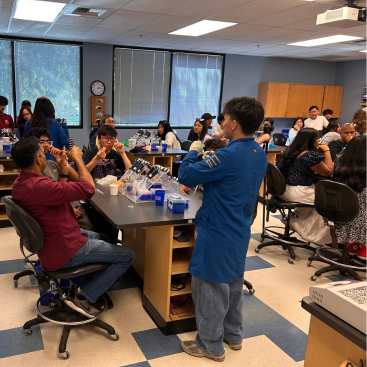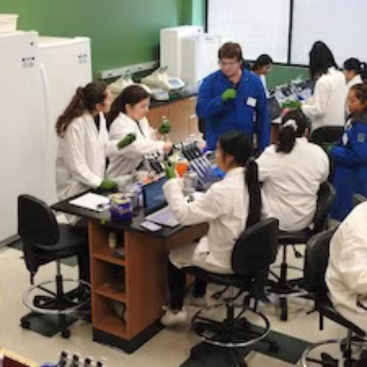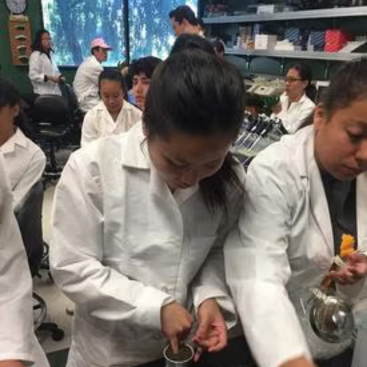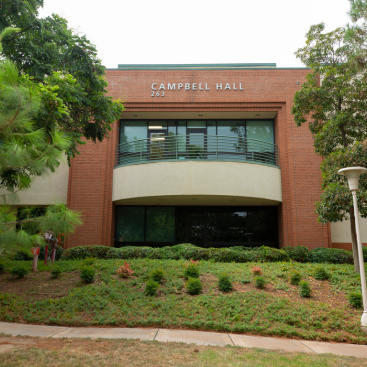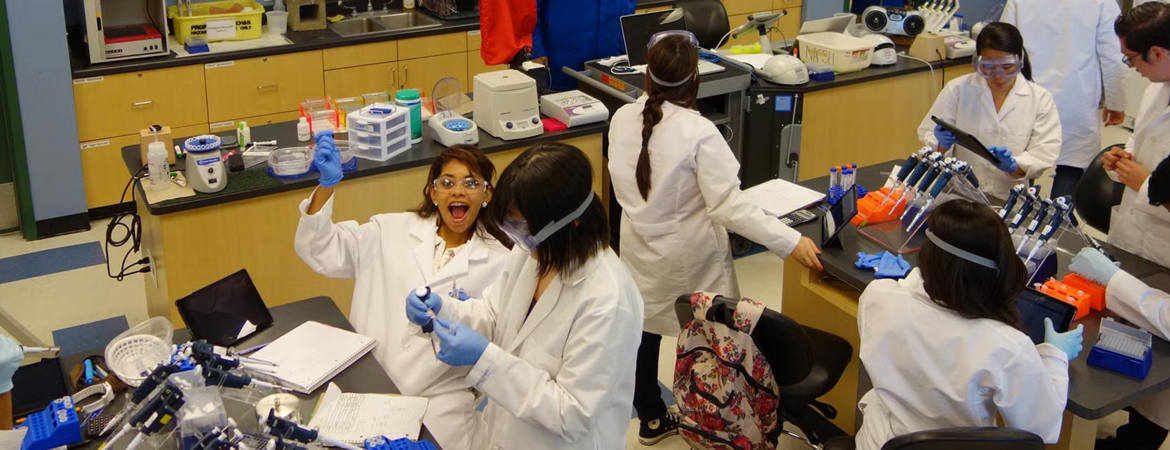
Jim Burnette, Ph.D., Academic Coordinator at UC Riverside, considers the Dynamic Genome Program (DGP) on campus as three-pronged, encompassing the Biology 020: Dynamic Genome Course, the Dynamic Genome Summer Scholars, and the Dynamic Research Outreach Program.
“But it is really so much more than that,” he says. “The program touches on so many aspects of the college and it’s mission. The benefits are very diffuse.”
According to Dr. Burnette, who has overseen the DGP at UCR since 2014, the main goal of the program is plain and simple: to excite the students about science.
“Some of these students come in as pre-med with an orientation about science that might only be entwined with how it relates to the medical profession,” he says. “But through the research they do with Dynamic Genome or through the research workshops, we impart information about what other things are available as a career in science.”
Dr. Burnette says research shows that the BIOL 020 course in particular helps students later in their Introductory 5A class. “That’s a good outcome,” he says. “Anecdotally speaking, two or three years later, students say what they learned in BIOL 020 helped them excel in a manner they couldn’t foresee at the time.
“Biology is an experimental science, and if you don’t really know what you’re doing, the textbook makes no sense,” Dr. Burnette continues, “If you don’t know what a Polymerase Chain Reaction really is and have only seen a diagram, it will remain an abstract concept.”
Susan Wessler, recently retired from UC Riverside but formerly Distinguished Professor and Geneticist in the Department of Botany and Plant Sciences, started the DGP at the University of Georgia in 2006, and soon enlisted the help of Dr. Burnette. In 2011, they transplanted the program to UC Riverside, with the first BIOL 020 course offered that fall.
Professor Wessler echoes Dr. Burnette about a prime goal of DGP being the desire to interest students who enroll in BIOL 020 in science.
“Most of them know they want to be science majors,” she says. “What we want them to do is stay in science. The reality is that the vast majority of students who start as pre-med don’t go to medical school.
“We tell them there are lots of things they could do besides go to medical school, such as going into industry, graduate school, or teaching science,” Professor Wessler continues. “We want them to get to love science via the experimentation, but then to tell them about the wide variety of job prospects and all the tangents that are available to them, fulfilling promise.”
The basic track of the DGP at UCR was to recreate Professor Wessler’s laboratory environment on campus, where graduate students, postdoctoral scholars, undergraduates and scientists could generate data and engage in bioinformatics, a discipline which uses computational tools and methods to analyze and manage biological data, particularly DNA and protein sequences.
Essentially, bioinformatics bridges biology and computer science to better understand and interpret biological information.
“That was the idea, both at the University of Georgia and originally here at UC Riverside,” Dr. Burnette says. “We had two rooms. One was a computer room where we did our bioinformatics and lectures and the other was a lab, basically going back and forth.”
The Dynamic Research Outreach Program, one of DGP’s three prongs, does just that - it canvases area middle schools, high schools and community colleges, and invites them to UC Riverside for a one-day workshop in the Campbell Hall laboratories.
“It’s more than just talking to them about science,” Dr. Burnette says. “It’s a good opportunity for near-peer mentoring, for the visiting students to talk to UC Riverside students and ask them why they chose to attend UCR. It’s good for recruitment, and we’ve had students that applied to UC Riverside after the outreach program. Last year, we had four workshops at 48 students each, so we had almost 200 students participating last year.”
And what’s been the feedback from the Outreach Program?
“I think the best assessment we have is that the same teachers keep bringing their students back every year,” Dr. Burnette says. “I’ve got a list of teachers expressing interest in doing workshops.”
Professor Wessler says that introducing students to experimental science via the DGP helps them to understand more than just hard facts, but how those facts are determined experimentally, which makes the field so exciting.
“It’s all about rolling up our sleeves and doing the actual work,” she says. “I remember telling students when you do an experiment, the vast majority of times, it fails, doesn’t work. They’d look at me with an ‘Is that true?’ look, and then they feel better at just the thought of being there in the lecture hall.”
Dr. Burnette explains that a distinguishing factor in the DGP is that every quarter, he partners with a scientist on campus to design a project based on the scientist’s research.
“It might be a graduate student or postdoc,” Dr. Burnette says. “That way, the undergrads work on a bona fide research project that often goes back to the lab itself and the graduate student continues with what the students generated in class.”
According to Dr. Burnette, the undergrads contribute to the research conducted on campus quite significantly. “It’s worked out really well vis-à-vis what the graduate students require – for example, if they need something replicated many times, the class of 24 students can help in the replication process pretty quickly. Maybe they need to screen for mutations that have been randomly generated, so the students can assist in that screen and save time.”
Some of the projects that undergrads have assisted on include the segregation of transposable elements in rice and determining the sex-specific genes in voles. Dr. Burnette says that they’ve even utilized a revolutionary technology to generate mutations called CRISPR, a gene-editing tool that allows scientists to precisely modify DNA sequences.
Quite a few faculty members have used BIOL O20 as impetus for National Science Foundation (NSF) grant proposals. “The NSF review panels tend to really like these projects that we do in the classes,” says Dr. Burnette. “We’ve probably had 12 or more faculty members offer projects as part of their NSF proposals.”
According to Polly Campbell, Associate Professor in the Department of Evolution, Ecology & Organismal Biology, “My lab’s participation in the Dynamic Genome Program is part of the Broader Impacts activities for my current NSF grant. The program at UCR provides students with valuable hands-on experience in genetics-focused lab work and introduces them to the basics of asking scientific questions, collecting data to address those questions, and interpreting their results.”
Another faculty member who uses research and researchers from the DGP is Morris Maduro, Divisional Dean of Life Sciences at the UC Riverside College of Natural & Agricultural Sciences (CNAS) and Professor of Biology in the Department of Cell, Molecular and Developmental Biology. Professor Maduro conducts basic research in developmental biology, using the nematode C. elegans and related species as model systems, and has twice taught BIOL 020, in 2014 and 2016.
In those two sections, he says he had students learn the basics of handling the nematodes, and how molecular biology and genetics experiments are done. Students were allowed to choose any human disease gene and find its candidate orthologue in C. elegans in order to perform RNA-mediated interference (RNAi) with it.
Although the students did not find any interesting phenotypes, the exercise was useful for students to learn how genetics research in a model system is performed. Professor Maduro says he is planning to teach another section of BIOL 020 in spring of 2025.
“It is important that students get an appreciation of how modern genetic analysis and bioinformatics experiments are performed,” he says. “The short time period of only 10 weeks makes doing more complex experiments challenging. However, most students learned enough about molecular biology, such as how to do PCR and run gels, that they could take those skills to a professor's laboratory to help conduct more extensive research with them.
"I am designing some experiments that may allow us to test some research hypotheses about gene evolution by doing RNAi in different species, for my next offering in spring of 2025,” he continues. “If we are able to get interesting results, we plan to follow up on them and perhaps publish them as well, with contributing students as authors.”
In 2018, UCR’s lab building was named the Rochelle and Alison Campbell Hall in recognition of the invaluable longtime support of the Campbell family. Rochelle Campbell is the widow of the late Neil Campbell, a well-known biologist and UC Riverside alumnus, and Allison Campbell is the couple’s daughter.
When speaking about the DGP at UCR, Dr. Burnette mentions the many covers of Professor Campbell’s seminal biology textbook, 12 editions in total, that visitors to the hall see when they first enter the building. He says Mrs. Campbell wants to make the textbook “come to life” for students.
For generations of biology students at UCR, it has done just that. And further, as UCR’s mission statement continues to launch new generations of “innovative thinkers” in part, by conducting research, the DGP fits like a glove into that purpose – just as Dr. Burnette says it does.
LEARN MORE ABOUT THE DYNAMIC GENOME PROJECT
